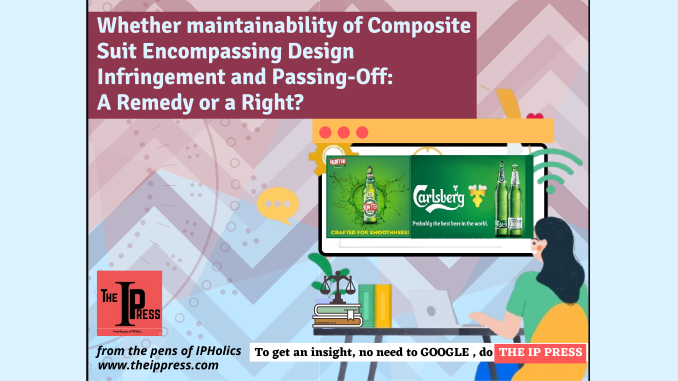

As truly laid down by the royal charter Magna Carta, “To no one will we sell, or deny, or delay, right or justice”
Design is that exquisite and artistic element which brings the feature of exclusiveness to a product. Any product can turn out to be outwardly engaging through its design. The Designs Act, 2000 secures these aesthetic appearances and sets out the vital specifications that are considered to be the prerequisites for registration of a design under the Design Act. While we know that Trademark law and Design law are two exclusive laws, there is often an interaction between most IP laws, for example, passing- off which is a common law remedy was earlier available only to trademarks but with the improvement in its scope, it has become a debatable topic with possible application to design laws as well. This has prompted various questions and discussions in the IP domain which are now being examined by the Indian Courts, for example, ‘Is the remedy of passing-off available under the Design Act, 2000?’, ‘Can a Composite suit be filed for registered Design Infringement and Passing-off of a Design?’, and ‘Can a passing-off suit be filed against a Design registrant?’. Consequently, this article discusses one of those significant scenarios as to whether composite suit in relation to registered design infringement and passing-off is maintainable in design law or not. Order II Rule 3 of CPC deals with the concept of composite suit or joinder of two causes of action and is of utmost significance in order to deal with the question as to whether two causes of action involving design infringement and passing-off may be joined and attempted in a single suit. The legal position on this aspect of law has gone through a colossal change considering the landmark Judgments passed by the judiciary alongside the ongoing case laws setting up a judicial trend under the system of Designs Act.
In this way, the dilemma has been absolved by the court on tenability of Composite suit in relation to design infringement and passing-off through a series of judicial precedents exceptionally in the landmark judgment of Carlsberg Breweries A/S. vs. Som Distilleries and Breweries Ltd.[1] decided by the Delhi High Court in which Carlsberg Breweries was using a unique and distinctive bottle in respect of its product design, i.e. beer, under the brand name ‘TUBORG’, registered under Designs Act, 2000. The plaintiff claimed that the novelty of the registered design resided in the shape and configuration of the bottle and alleged that its product was being sold with a distinctive trade dress by Som distilleries, who were marketing its product under the brand name ‘HUNTER’. Carlsberg’s primary contention was that the defendant, had adopted an imitation of the registered bottle design, registered label mark and trade dress in respect of its product, which was not only leading to infringement of Carlsberg’s registered bottle design and infringement of its trademark contained in the ‘clockman shape label’, but also leading to passing-off its products. Carlsberg contended that Som Distilleries was not only using the bottle but also utilizing the label, cap, trade dress, and get-up which was a comprehensive imitation of Carlsberg’s registered bottle design. Along these lines, the issue that emerged in this case was whether two causes of action can be joined in a single suit, one being the infringement of a registered design and other being passing-off of plaintiff’s goods or articles. The court while deciding upon the case made reference to the Delhi High Court’s judgement in Mohal Lal vs. Sona Paint & Hardwares and Ors.[2], after Som Distilleries contended that two causes of action relating to design infringement and passing-off being different must be filed separately. In Cello Household Products vs. Modware India[3], where joinder of causes of action concerning design infringement and passing off actions was held tenable in one suit, this particular rationale in Mohan Lal’s case was not taken into account by the Bombay High Court. Be that as it may, Mohan Lal’s judgment was still applicable in the Delhi High Court dominion, till it was overruled by Carlsberg’s judgment.
Consequently, the Carlsberg case overruled the Mohal Lal case where it was held that two separate suits have to be filed considering that the causes of action for design infringement and passing- off claim are different from each other. The court in Mohan Lal case firstly, relied on Dabur India Limited vs. K.R. Industries[4], wherein the question in issue was applicability of the jurisdiction of the court and where the Supreme Court conclusively determined that the two causes of action cannot be combined. Secondly, reference was also taken from the case M/s Dhoda House vs. S.K. Maingi[5] wherein the Supreme Court dealt with the issue of maintainability of a composite suit with respect to copyright infringement and trademark infringement and finally did not consider the maintainability of the said composite suit. Thus, the Delhi High Court in the Carlsberg case subsequently after interpreting the judgement in the Mohan Lal case, held that the court in the Mohan Lal case had inaccurately applied the precedent laid down in the Dabur and Dhoda House case thereby observing that neither of the cases were related to design infringement and passing-off and also that the principle of infringement and passing-off are divergent to each other, thus nullifying the ground on which the Mohan Lal judgement was based.
Therefore, in respect to the question on maintainability of composite suits the court relied on Prem Lata Nahata vs. Chandi Prasad Sikaria[6], thereby pointing out the relevance of joining two suits which according to their view is to make various actions more placid by treating them in one suit further saving cost, time and effort of the parties involved in the suit as well as the court. Consequently, the court further observed that two causes of action can be joined when substantial evidence of such actions is common as per Order II Rule 3 CPC but if they are different then causes of action cannot be joined. The court then relied on the caseof Kusum Ingots & Alloys Ltd. vs. Union of India[7],and deciphered the term ‘cause of action’ and interpreted it to mean “every fact which would be necessary for the plaintiff to prove, if traversed, in order to support his right to the judgment of the Court”. The court further placed reliance on Girdhari Lal (Dead) by LRs. vs. Hukam Singh & Ors[8] in order to clarify the concept of misjoinder of causes of action and further, elucidating that a suit cannot be dismissed due to misjoinder of causes of action. In light of the above mentioned cases, the Court finally took reference from the case of M/s. Jay Industries vs. M/s. Nakson Industries[9], and opined that in a situation where the causes of action emerge from one particular transaction then they can be joined. In furtherance of the same, the court after citing and drawing inference from the above mentioned precedents opined that in a situation where claims of design infringement and passing-off arise from a single transaction then these two causes of action will have a common point of facts and questions which will further connote that the two causes of action will have common evidence. Therefore, a composite suit with respect to design infringement and passing-off action against the same defendant may be filed in order to circumvent a situation of multiplicity of proceedings. Similarly, in the case of M/S Crocs Inc. USA vs. Bata & Ors[10], Crocs Inc. USA the proprietor of certain registered designs of footwear in India filed 6 cases encompassing design infringement and passing- off against Bata, Liberty Shoes, Aqualite, Bioworld Merchandising India, Relaxo and Action Shoes respectively with respect to the shape of the footwear claiming piracy of its design under Section 22 of the Design’s Act, 2000. Crocs in its suit alleged design infringement related to the perforated and non- perforated shoe design and thus filed a suit seeking permanent injunction against all the Defendants from manufacturing, supplying, using, selling, advertising etc. their product having deceptive similarity to the plaintiff’s design. The Delhi High court in this case in dealing with the issue of composite suit for design infringement and passing- off held that the Defendants were not guilty of design infringement and no passing-off action existed against Bata & Ors.
Needless to say, the law can bar a remedy but not the right of a person as seen in the Mohan Lal case where the right of a person to join his two causes of action was barred. But, in the Carlsberg case the right of a person was restored, thereby uplifting the maintainability of the composite suit in relation to registered design infringement and passing-off to save time and resources of the court as well as parties. In doing so, the judiciary has also lined up the protection given to the rights of the proprietor under design law with the protection given to other forms of IP rights as well, such as trademarks and copyright, and is profoundly significant as it will reduce the multiplicity of proceedings.
[1] 256 (2019) DLT 1
[2] AIR 2013 Delhi 143
[3] AIR 2017 Bom 162
[4] (2008) 10 SCC 595
[5] (2006) 9 SCC 41
[6] (2007) 2 SCC 551
[7] (2004) 6 SCC 254
[8] (1977) 3 SCC 347
[9] AIR 1992 Del 338
[10] [RFA(OS)(COMM) 22/2019]

Leave a Reply